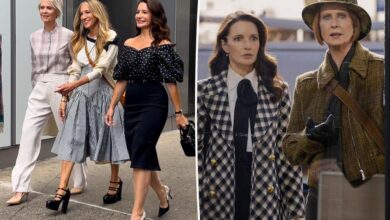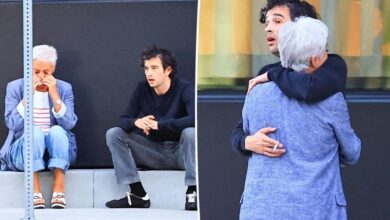Zohran Mamdani’s NYC could look like Sadiq Khan’s far-left London

Many of my friends and former neighbors in New York — where I lived for 27 years — are anxious about the city’s future if it elects as mayor a self-proclaimed Muslim socialist. Another great world capital already offers a glimpse of what might lie ahead: London, under its far-left mayor, Sadiq Khan.
I recently returned to my native London for the first time in more than two decades. What I found wasn’t the inclusive, cosmopolitan capital I had known and loved but a city so altered in tone and appearance that I scarcely recognized it. Over the course of a fortnight in June, neighborhood after neighborhood left me feeling not just like a visitor, but like a stranger in my own birthplace. At times, I felt more as though I was in Dubai rather than London.
Mayor Sadiq Khan — a Muslim of Pakistani heritage — has aggressively pursued a pro-immigration agenda during his last eight years. Kahn’s London offers housing and social services that are a magnet for the record number of illegal immigrants flooding into Britain. Kahn was reelected for a third term in May 2024.
This isn’t about race or immigration alone. Nor is it nostalgia for some imagined golden era. I’m the daughter of first-generation Jewish immigrants from Eastern Europe and grew up in multicultural London during the 1950s and ’60s. My childhood circle included Afro-Caribbean and Persian friends. Our high street bustled with South Asian-owned shops and takeaways run by newly arrived strivers from former British colonies. My father’s kosher tailor shop stood proudly on Brick Lane, even as the East End transformed from a Jewish enclave into a Bangladeshi stronghold. These shifts felt organic —imperfect, yes, but cohesive. There was a sense of shared direction. The antisemitic bullying I experienced at school came exclusively from native-born white Britons — not immigrants.
This time, the transformation felt fundamentally different.
What struck me wasn’t just the arrival of new communities but the visible dominance in many neighborhoods of conservative Middle Eastern and Muslim cultural norms. It wasn’t just demographic change but a palpable shift in the very atmosphere of public life.
In shops, pharmacies, cafés, and on the Tube, I repeatedly encountered women in full niqab and men in traditional thawbs. What was missing was the gradual integration I remembered from my youth. I saw no sign these communities were blending into the broader civic culture — or even being encouraged to. What I saw wasn’t diversity but cultural segregation. Not integration, but parallel societies.
Some have suggested my timing — arriving during Eid al-Adha — might have skewed my impression. Perhaps. But while that might explain the Rolls-Royces and Lamborghinis with Emirati plates outside Mayfair hotels, it doesn’t explain the sense of dislocation I felt in ordinary boroughs, far from the luxury districts.
I wore my Star of David necklace every day, as I always do. Given the alarming rise in antisemitic incidents in Britain since Oct. 7, I was prepared to feel uneasy. I avoided the large pro-Hamas marches that openly call for the expulsion of Jews from the UK.
I was warned about no-go zones governed by informal sharia norms, where Western faces are unwelcome. Even so, in public spaces, when someone spotted my necklace, I noticed sidelong glances, whispered comments, the occasional nudge. It was subtle — but unmistakable.
At the Wallace Collection museum in upscale Marylebone, I struck a conversation with a small group of fellow Brits who were there admiring the art. When I happened to mention that I was Jewish, things took an awkward turn.
“I hope that doesn’t make anyone uncomfortable,” I joked. What followed was a long, brittle pause — then a few polite smiles and the obligatory, “Of course not.” But the silence said far more than the words.
This is not the London I left in 1978, when I moved to the United States. Nor is it the city I returned to often in the ’80s and ’90s for extended family visits. Back then, London had become a truly global capital — vibrant, polyglot, and mostly harmonious. I never lived in a bubble.
While I now live in Miami, I’ve followed UK news closely and stayed in touch with friends and relatives. I knew London had changed. What I did not expect was how alienated and unwelcome I felt in the city that raised me.
To express these concerns is to risk accusations of bigotry or reactionary nostalgia. But acknowledging what many Britons — of all backgrounds — quietly feel is not an act of prejudice. It’s an act of candor. I write this not to stoke division but to urge honest dialogue.
The promise of a pluralistic society isn’t that we live side-by-side in self-contained silos but that we build a common life together.
A Zohran Mamdani New York will not be transformed overnight. But if Mamdani moves to double down on sanctuary policies for undocumented migrants while driving out the tax base needed to fund his socialist ambitions, the city I love could soon follow London’s path.
London’s diversity once made me proud. I still believe in its potential. But I say this with sorrow, not anger: London no longer feels like home. It has been taken over.
Is New York next?
Patricia Posner is the executive director of Antisemitism Watch.
Credit to Nypost AND Peoples




